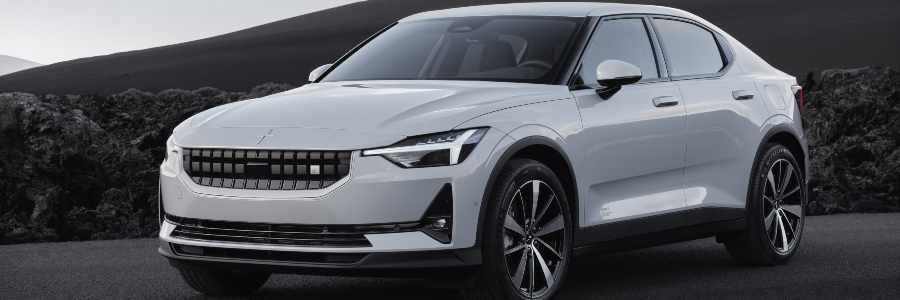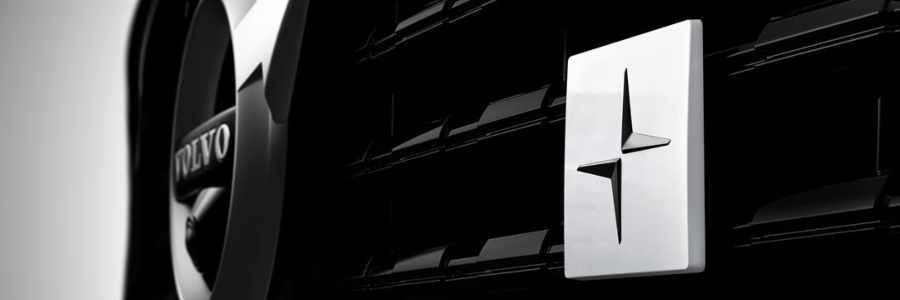Polestar turned heads with the arrival of its fully electric vehicle in 2020, the Tesla Model 3 finally had a real rival. The Swedish automotive brand has been challenging traditional ways of doing a lot of things. There are no in-person showrooms to see the Polestar vehicles, everything is digitised and sustainable. If you ever do need to visit in person for a service for your Polestar car, you’re to be treated as royalty (almost). But what exactly is Polestar reliability like? Does it offer the best electric car on the market? Could the Polestar 2 be your next vehicle?

What is Polestar reliability like?
Is a Polestar car any good? The Volvo brother brand offers just two different models. The Polestar 1 is a hybrid model, and then the fully electric Polestar 2. Offering just a simple line-up aligns very well with Polestar’s “detail-oriented minimalism”.
But what is Polestar reliability like? Is it a manufacturer you can trust? As the brother brand of Volvo, we can assume that both the brand’s reliability will align together. Volvo’s V40 scored a 93% reliability score thanks to a 2021 reliability survey by What Car? Want to find out more about Volvo’s reliability? Read our thorough article which investigates how reliable is Volvo?
The hybrid model Polestar 1 overall got impressive reviews and ratings, with What Car? giving three out of five stars. However, with only a left-hand drive, this model isn’t ideal for UK drivers so it’s not a car that’s accessible to all.
If you’re considering going electric, then the Polestar 2 is a fantastic first choice. Polestar 2 received collective praise from a multitude of reviews namely Top Gear, Auto Express, What Car? and Car Magazine giving it an average rating of 8/10. So, it’s easy to trust that the Polestar is a great vehicle with excellent reliability.

Polestar 2 Range – Is it any good?
The model offers an electric range covering from 255 to 339 miles, with 0-60mph in 7.0 seconds. The all-wheel drive vehicle can charge from 10-80% in 32 minutes with rapid charging.
Who has time for that?
Well, you see, the mileage of the average UK driver is 130 miles a week. Let’s assume they drive a Polestar 2; this means with a vehicle that has a range of 339 miles would need to charge maybe every two to three weeks.
Unlike petrol and diesel cars, EV owners have the advantage of filling up their cars from the comfort of their homes. So, if anything, you could be saving yourself not only money but time as well!
If you’re interested only in the technical spec of the Polestar 2, then we’d recommend you stop reading from here.
Otherwise, answer this question: would you prefer to invest in a company that treats you well? Seems like a silly thing to ask.
Well, to Polestar customer service is no joke. Any Polestar buyer or owner that approaches a Volvo dealership is to be treated like a VIP.
On top of this, the premium brand offers innovative digital customer service challenging the existing conventional car dealerships and showrooms…this basically means that their showrooms are online – very covid friendly! Plus, this means it’s accessible to people across the globe, furthering their brand belief of keeping things as environmentally sustainable as possible.
Who makes Polestar cars?
So, who makes Polestar vehicles? Well, Polestar was established in 1996 by the more famously known Swedish automotive brand Volvo, and then finally developed as a brand by 2015. It has been Volvo Cars’ performance partner for over two decades.

In 2017 it was announced by Volvo that Polestar would begin making premium electric cars under its own name and badge. Its vehicle production centre takes place in Chengdu, China.
The Polestar car production centre is reportedly one of the most environmentally responsible in the country, with the goal of winning Gold Status in the Leadership in Energy and Environmental Design (LEED) ratings.
Polestar is also known as Volvo’s performance vehicle brand. So, if you’re a fan of Volvo vehicles, but want something more exciting or exhilarating, and want a car with great reliability, then Polestar is the way to go.
It’s stated that the performance brand’s engineering philosophy is to create a predictable, safe and balanced driving experience.
Why is a Polestar car so expensive?
Are you wondering why polestar is so expensive? Have you fallen in love with its looks, and what the company stands for and then seen the price tag? There are many factors to take into consideration when it comes to the cost of a Polestar car.
Firstly, the brand offers just two vehicles. This along with their promise of an engaging, fun, and confident drive, without compromises, it’s safe to trust that these vehicles are reliable and well worth the price.
When you compare the Polestar to its direct rivals such as the Tesla Model 3, Audi Q4 e-tron and the Mercedes EQC – with the highest asking price of around £65,000. Compare this to the electric Polestar for just £49,900 can it really be said that the Polestar 2 is too expensive?
The question you really may be asking is, why are electric cars so expensive? The answer to this relies on electric vehicle technology. The hefty price tag on electric vehicles is due to the fact that the EV market is still relatively new, and the technology is ever-growing, similar to smartphone technology.
Typically, when the latest Apple iPhone is released it’s often around £1,000 more expensive than its predecessor.
Why?
Because it offers new and innovative technology that the other models cannot. The expense of EVs, in addition to this, is down to the recent effects of COVID-19 and the microchip semiconductor shortage that was impacted by the pandemic.
One thing that’s often forgotten is the savings that actually come with electric vehicles. A few prime examples are the tax benefits, fuel-saving costs and the amount of time you save. For more in-depth information about EVs read our article about the advantages of electric cars.
How expensive electric vehicles are is also a very good reason why leasing your electric car is a fantastic way to invest in going electric. Not only do you enjoy all the financial and time-saving benefits, but you are also saving yourself from the worries and stress of the vehicle depreciating.

Is Polestar worth it?
Now that we’ve evaluated Polestar reliability, now is time to question: is Polestar worth it? Whether or not it’s worth investing in a Polestar vehicle completely depends on if you buy, finance or lease your electric vehicle.
OSV’s advice for all-electric vehicles at this point in time is to lease. This is partly due to the fact that the EV sector is still relatively new and not quite developed to its full potential.
You could compare investing in electric vehicles the same as you would with a mobile phone contract. Smartphone technology is forever changing and developing, there’s always a better model to upgrade to every few years and it’s never guaranteed that the phone you buy outright will be up to scratch in three years’ time when better options will be available.
Although there are a lot of plus points to leasing a Polestar, it is a brand that is rarely enquired about. More often than not, people want to drive a Tesla, usually because it is known as a Tesla.
When it comes to finding your perfect vehicle, the service you receive is a vital part of the process. So, what did Trustpilot have to say about Tesla and Polestar?
According to Trustpilot, both electric car brands came on par with a score of 2.4 stars out of 5 (as of writing 7/1/22). The general comments from Tesla’s customers questioned how effective its customer service was. With Polestar, customers criticise the brand for software and delivery issues.
Polestar, which is a relatively new brand, received just 27 reviews to date versus Tesla which has received a total of 800 reviews. These ratings are likely to change over time however as it currently stands the brands aren’t too dissimilar in the eyes of their customers.

Polestar Car Warranty
So, maybe now you’re considering going electric, maybe even choosing which colour of the Polestar 2 you’d like. Before thinking about specifics and jumping ahead, it’s important to plan how and if you’ll be covered for scrapes on the paintwork and general mishaps.
The cover ranges from three, eight and 12-year types of alternative warranty which promise to fix any part of your Polestar that breaks down due to faulty materials and/or manufacturing issues.
What is the Polestar 2 Warranty?
Anyone thinking of getting a Polestar 2 will be pleased to hear the warranty offers up to 12 years of coverage.
However, this does only include repairing and/or replacing any affected panels of sheet metal that have rusted due to faulty materials or construction.
Within the first three years of ownership or before 60,000 miles, you are covered for any faulty materials or manufacturing issues, this includes the battery pack.
What is the Polestar battery warranty?
The lithium-ion battery is a very important part of your Polestar car, so you’d expect a decent warranty for your electric ‘engine’. Thankfully, they offer just that.
You can enjoy free repairs on any material defect within the first 8 years of ownership or 100,000 miles driven – whichever comes first.
It’s also worth mentioning that any decrease in battery capacity is considered normal and so is not covered under the warranty.
Should I buy, lease or finance a Polestar Car?
Now we have completely dug into Polestar reliability, how about if you should get one for yourself?
Going back on what was said before whether you should buy, lease or finance a Polestar car completely depends on your circumstances and what you want to do. Fans of electric vehicles, whether Polestar or other, would normally opt to lease.
Why don’t we recommend outright buying an electric car?
In this day and age EV technology is still very new and has years of future development to come. In addition, the cost of doing something as simple as changing the battery of your EV outweighs the ‘investment’ of buying the vehicle altogether.
Changing the battery can’t be that expensive, right?
On average you’ll spend around £8,000 on swapping the battery out for a new one. Currently, batteries need replacing between 10 and 20 years although this could easily change in the future.
To conclude, leasing a Polestar car helps you not only save yourself from future vehicle depreciation and financial savings, but it also gives you the opportunity to experience an electric vehicle without the full commitment.
So, exactly how reliable is Polestar?
Keep in mind the customer service, incredible build quality and abundant positive reviews of both Polestar and Volvo. It’s more than easy to trust you’ll be driving an electric car that radiates reliability.


Im impressed with the general appearence of the polestar2, but couldnt possibly go ahead with a purchase unless i see one in the flesh, how can i do this before going ahead and buying.
Thanks
Bfian
Hi Brian, we would recommend contacting your local Polestar dealership and requesting a test drive of the Polestar 2 if it is available. Alternatively, you can watch our most recent review of the electric model: bit.ly/3ud0qYo
My son rented one for his 26th birthday trip to Miami Beach and he loved driving the car. He said only drawback was having to charge more frequently than the Tesla. Driving range on highway was short.
Hi there Therese, that’s fantastic to hear. Thank you for sharing your son’s honest review of the Polestar 2.
This is a very misleading article. Polestar is a wholly owned subsidiary of the Chinese auto manufacturer Geely. It isn’t Swedish in the slightest. Wholly Chinese owned and made. To say otherwise is deceptive.
Thank you for sharing your thoughts, Sean! We appreciate your perspective on the matter. While Polestar is indeed associated with Geely, it’s also worth noting that the brand originated in Sweden and maintains a strong design and engineering presence there. We understand that perceptions can vary, and our aim is to provide accurate and balanced information to our readers. If you have any more insights or questions about the automotive industry, feel free to ask!